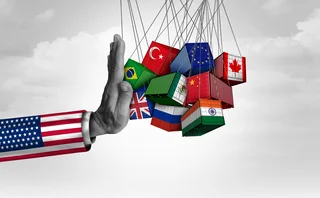
Don’t fret about elevated skew, vol experts say
Extreme relative cost of tail risk hedging is driven by flows more than fear

Downside equity skew — a measure sometimes taken as an indicator of nervousness in markets — has reached all-time highs, leaving investors wondering whether they should worry. Volatility experts say not. In fact, high skew may present an opportunity.
Rather than signalling trouble ahead, the extreme skew is due mostly to market flows, the experts argue.
“The volatility surface is always about how supply and demand interact,” says Yanko Punchev, senior portfolio manager at €50 billion asset
Only users who have a paid subscription or are part of a corporate subscription are able to print or copy content.
To access these options, along with all other subscription benefits, please contact info@risk.net or view our subscription options here: http://subscriptions.risk.net/subscribe
You are currently unable to print this content. Please contact info@risk.net to find out more.
You are currently unable to copy this content. Please contact info@risk.net to find out more.
Copyright Infopro Digital Limited. All rights reserved.
As outlined in our terms and conditions, https://www.infopro-digital.com/terms-and-conditions/subscriptions/ (point 2.4), printing is limited to a single copy.
If you would like to purchase additional rights please email info@risk.net
Copyright Infopro Digital Limited. All rights reserved.
You may share this content using our article tools. As outlined in our terms and conditions, https://www.infopro-digital.com/terms-and-conditions/subscriptions/ (clause 2.4), an Authorised User may only make one copy of the materials for their own personal use. You must also comply with the restrictions in clause 2.5.
If you would like to purchase additional rights please email info@risk.net
More on Investing
How Trump’s trade talks may play out
SSGA’s chief geopolitical strategist on which tariffs stay in place and who blinks first in negotiations
Market whipsaw spurs calls to rethink buy-side stress-testing
Risk Live Boston: Morgan Stanley and BlackRock urge rethink of scenario assumptions and top-down factor models
MSU endowment beats peers by ‘not minding that it hurts’
CIO Philip Zecher rides out tariff storm with long-term view; singles out ‘Mag 3’ tech stocks
The end of the world, or an artificial crisis?
Bimodal tariff threat leaves investors grappling with uncertainty
Hedging playbook goes ‘out the window’ as Trump tariffs slam markets
Dispersion, put spreads and VKOs paid off as stocks plunged, but outlook remains wildly uncertain
The case for believing in a Bessent put
Money market funds could prove critical in efforts to control 10-year yields
Hedge funds flock to hybrids to trade macro uncertainty
Firms repurpose structure made popular by Trump trades last year
Can Bessent lower 10-year yields? Investors have their doubts
Unconventional tools won’t sway bond markets, say buy-siders, with yields as likely to go higher as lower








